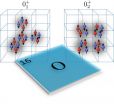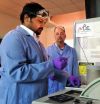(Press-News.org) Every cell in the body has to sense and respond to chemicals such as hormones and neurotransmitters. They do so by relaying information from receptors to intracellular biochemical pathways that control cell behaviour, but relatively little is known about how cells decode the information in dynamic stimuli.
A team of researchers have found that differences in response kinetics working down the intracellular signalling pathway dictate differential sensitivity to different features of pulsatile hormone inputs.
The study funded by the BBSRC and published today [14 March] in the Journal of Biological Chemistry, explored mechanism underlying dynamic gonadotropin-releasing hormone (GnRH) signalling using live cell imaging and mathematical modelling.
The research team, led by Craig McArdle, Professor of Molecular Pharmacology at the University of Bristol's School of Clinical Sciences, in collaboration with the University of Exeter, focused on the ERK signalling pathway as this enzyme is activated by GnRH pulses and is essential for normal reproduction.
The neuropeptide hormone GnRH is secreted in pulses from neurons in the hypothalamus and controls secretion of two pituitary hormones, the LH and FSH that, in turn, control production of germ cells and sex steroids.
This system provides the interface between the brain and the reproductive system. It is absolutely essential for normal reproduction and is targeted therapeutically in assisted reproduction and in the treatment of hormone-dependent diseases, such as breast and prostate cancer.
The study found that for effects on gene expression the system is more sensitive to changes in GnRH receptor number than it is to changes in GnRH concentration, and is more sensitive to changes in GnRH interval than it is to changes in GnRH pulse width.
Professor Craig McArdle said: "The work revealed "design-features" of the system that make perfect sense in light of the biology, where GnRH receptor number and GnRH pulse interval vary, for example, through puberty and through the menstrual cycle.
"These features are relevant to numerous biological systems using pulsatile stimuli and suggest intriguing mechanisms for differential control of rapid and delayed responses with dynamic stimuli."
Professor Krasimira Tsaneva-Atanasova, Associate Professor of Mathematics at the University of Exeter and co-author on the paper said: "The effects of a signalling molecule can be fast or slow and the same signalling molecule will often elicit a rapid, transient response from a cell followed by a slower, long term change in cell behaviour.
"How fast and slow molecular pathways are modulated by pulsatile, or dynamic, inputs is particularly important for understanding GnRH signalling in physiologically relevant stimulation paradigms and identifying new tools that could be used for fertility control and treatment of hormone-dependent cancer."
Billions are spent every year on GnRH receptor ligands and the stimulation paradigm is absolutely crucial for therapeutic applications, but remarkably little is known about how the target cells and tissues decode GnRH dynamics.
The work is strengthened by the collaboration between the University's School of Clinical Sciences and School of Mathematics together with the Department of Maths at the University of Exeter, and the study illustrates the additional insight to be gained from such collaborative "maths-driven biology".
INFORMATION:
Paper: Pulsatile Hormonal Signaling to Extracellular Signal-Regulated Kinase: Exploring System Sensitivity to Gonadotropin-Releasing Hormone Pulse Frequency and Width, Rebecca M Perrett, Margaritis Voliotis, Stephen P Armstrong, Robert C Fowkes, George R Pope, Krasimira Tsaneva-Atanasova, Craig A McArdle, The Journal of Biological Chemistry, Vol. 289, Issue 11, 7873-7883, March 14, 2014.
Mathematical and biochemical 'design features' for cell decoding of pulses revealed
2014-03-13
ELSE PRESS RELEASES FROM THIS DATE:
Researchers describe oxygen's different shapes
2014-03-13
Oxygen-16, one of the key elements of life on earth, is produced by a series of reactions inside of red giant stars. Now a team of physicists, including one from North Carolina State University, has revealed how the element's nuclear shape changes depending on its state, even though other attributes such as spin and parity don't appear to differ. Their findings may shed light on how oxygen is produced.
Carbon and oxygen are formed when helium burns inside of red giant stars. Carbon-12 forms when three helium-4 nuclei combine in a very specific way (called the triple alpha ...
Creating a graphene-metal sandwich to improve electronics
2014-03-13
RIVERSIDE, Calif. — Researchers have discovered that creating a graphene-copper-graphene "sandwich" strongly enhances the heat conducting properties of copper, a discovery that could further help in the downscaling of electronics.
The work was led by Alexander A. Balandin, a professor of electrical engineering at the Bourns College of Engineering at the University of California, Riverside and Konstantin S. Novoselov, a professor of physics at the University of Manchester in the United Kingdom. Balandin and Novoselov are corresponding authors for the paper just published ...
UT Arlington research says treadmill workstation benefits employees, employers
2014-03-13
Employees who use treadmill workstations not only receive physical benefits but also are more productive at work, according to a recently published study by researchers from The University of Texas at Arlington, the Mayo Clinic and the University of Minnesota.
Darla Hamann, an assistant professor in the UT Arlington School of Urban and Public Affairs, and four colleagues wrote "Treadmill Workstations: The Effects of Walking while Working on Physical Activity and Work Performance", which was published by the journal PLoS One Feb. 20.
In the study, sedentary employees from ...
Heart scans only useful in prescribing statins under certain conditions, UCSF team reports
2014-03-13
As long as inexpensive statins, which lower cholesterol, are readily available and patients don't mind taking them, it doesn't make sense to do a heart scan to measure how much plaque has built up in a patient's coronary arteries before prescribing the pills, according to a new study by researchers at UC San Francisco.
The researchers created a statistical model to predict whether or not it made sense to do the scan, using data from the Multi-Ethnic Study of Atherosclerosis and other sources. They modeled the effects of statin treatment in 10,000 55-year-old women with ...
Researchers destroy cancer with cryoablation & nanoparticle-encapsulated anticancer drug
2014-03-13
Combining nanodrug-based chemotherapy and cryoablation provides an effective strategy to eliminate cancer stem-like cells (CSCs) the root of cancer resistance and metastasis, which will help to improve the safety and efficacy of treating malignancies that are refractory to conventional therapies.
Cryoablation (also called cryosurgery or cryotherapy) is an energy-based, minimally invasive surgical technique that has been investigated to treat a variety of diseases including cancer, which is done by freezing the diseased tissue to subzero temperature to induce irreversible ...
Same-day double knee replacement safe for select rheumatoid arthritis patients
2014-03-13
Same-day bilateral knee replacement surgery is safe for select patients with rheumatoid arthritis, researchers from Hospital for Special Surgery in New York have found.
Generally, patients with an inflammatory systemic disease such as rheumatoid arthritis (RA) are sicker than patients with the degenerative condition osteoarthritis (OA), says senior study author Mark Figgie, M.D., chief of the Surgical Arthritis Service at Hospital for Special Surgery, and the hospital's first Allan E. Inglis, MD, Chair in Surgical Arthritis.
RA patients are more likely to have conditions ...
Heat-based technique offers new way to measure microscopic particles
2014-03-13
Researchers have developed a new heat-based technique for counting and measuring the size of microscopic particles. The technique is less expensive than light-based techniques and can be used on a wider array of materials than electricity-based techniques. The research was performed by faculty at North Carolina State University, the University of North Carolina at Chapel Hill and Marquette University.
"We launched this study purely out of curiosity, but it's developed into a technique that has significant advantages over existing methods for counting and measuring the ...
A brake for spinning molecules
2014-03-13
This news release is available in German. Chemical reactions taking place in outer space can now be more easily studied on Earth. An international team of researchers from the University of Aarhus in Denmark and the Max Planck Institute for Nuclear Physics in Heidelberg, discovered an efficient and versatile way of braking the rotation of molecular ions. The spinning speed of these ions is related to a rotational temperature. Using an extremely tenuous, cooled gas, the researchers have lowered this temperature to about -265 °C. From this record-low value, the researchers ...
Soft robotic fish moves like the real thing
2014-03-13
Soft robots — which don't just have soft exteriors but are also powered by fluid flowing through flexible channels — have become a sufficiently popular research topic that they now have their own journal, Soft Robotics. In the first issue of that journal, out this month, MIT researchers report the first self-contained autonomous soft robot capable of rapid body motion: a "fish" that can execute an escape maneuver, convulsing its body to change direction in just a fraction of a second, or almost as quickly as a real fish can.
"We're excited about soft robots for a variety ...
Heritable variation discovered in trout behavior
2014-03-13
Populations of endangered salmonids are supported by releasing large quantities of hatchery-reared fish, but the fisheries' catches have continued to decrease. Earlier research has shown that certain behavioural traits explain individual differences in how fish survive in the wild. A new Finnish study conducted on brown trout now shows that there are predictable individual differences in behavioural traits, like activity, tendency to explore new surroundings and stress tolerance. Furthermore, certain individual differences were observed to contain heritable components. ...




